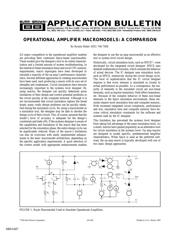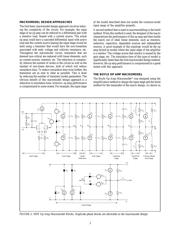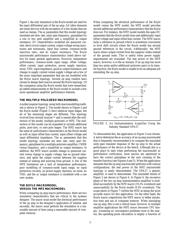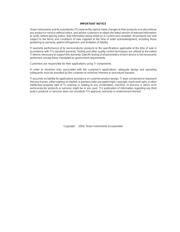herunterladen

All major competitors in the operational amplifier markets
are providing their customers Spice-based macromodels.
These models give the designer a tool to do initial character-
ization and a limited amount of system troubleshooting. In
the interest of faster simulation times and lower CPU memory
requirements, macro topologies have been developed to
simulate a majority of the op amp’s performance character-
istics. Several different approaches to creating macromodels
have been used, each producing a macro with its own set of
strengths and weaknesses. Circuit simulations have become
increasingly important to the systems level designer. By
using macros, the designer can quickly determine gross
limitations of their design and correct potential problems in
the circuit quickly at the computer terminal. Although it is
not recommended that circuit simulation replace the bread
board, many costly design problems can be quickly identi-
fied during the simulation cycle. By using a macromodel as
a simulation tool, the designer may be able to shorten the
design cycle of their circuit. This, of course, assumes that the
model’s level of accuracy is adequate for the design’s
constraints and trade offs. If the systems designer is aware of
the capabilities and limitations of the macro that has been
selected for the simulation phase, the entire design cycle can
be significantly reduced. Many of the macro’s limitations
can also be overcome with easily implemented enhance-
ments to the basic macromodel architecture, depending on
the specific application requirements. A good selection of
the correct model with appropriate enhancements enables
the designer to use the op amp macromodel as an effective
tool in system level circuit design.
Historically, circuit simulation tools, such as SPICE
(1)
, were
developed for the integrated circuit designer. SPICE uses
detailed mathematical formulas, which emulate the behavior
of actual devices. The IC designer uses simulation tools,
such as SPICE, extensively during the circuit design cycle.
The level of sophistication that the IC circuit designer
requires is that every element is simulated as closely to
actual performance as possible. As a consequence, the ma-
jority of elements in the simulated circuit are non-linear
elements, such as bipolar transistors, field-effect transistors,
etc. Because of the complex behavior of these non-linear
elements in the Spice simulation environment, these ele-
ments require more simulation time and computer memory.
With increased integrated circuit complexity, performance
and size, simulation time and computer memory have be-
come critical simulation constraints for the software and
systems used by the IC designer.
This limitation has prevented the systems level designer
from taking full advantage of the same simulation tools. As
a result, macros have gained popularity as an alternative tool
for circuit simulation at the systems level. Op amp macros
are designed to model specific, predetermined amplifier
characteristics. When Spice is used as the preferred soft-
ware, the op amp macro is typically developed with one of
two basic design approaches.
I
SS
+In
–In
14
15 16
C
1
J
1
J
2
R
3
R
4
R
P
D
1
R
2
C
2
R
1
C
3
R
O1
Out
V+
V–
V
8
+
V
7
+
D
5
V
6
+
V
2
+V
1
+
G
1
R
5
22
D
4
G
2
G
3
V
4
+
+
V
3
+
V
5
D
3
D
2
FIGURE 1. Boyle Macromodel Used to Simulate Operational Amplifiers.
OPERATIONAL AMPLIFIER MACROMODELS: A COMPARISON
By Bonnie Baker (602) 746-7468
APPLICATION BULLETIN
®
Mailing Address: PO Box 11400 • Tucson, AZ 85734 • Street Address: 6730 S. Tucson Blvd. • Tucson, AZ 85706
Tel: (602) 746-1111 • Twx: 910-952-111 • Telex: 066-6491 • FAX (602) 889-1510 • Immediate Product Info: (800) 548-6132
©
1993 Burr-Brown Corporation AB-046 Printed in U.S.A. March, 1993
SBOA027







